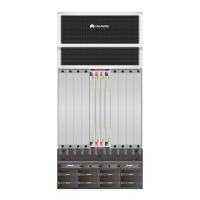1.10.3 Switching Network
1.10.3.1 Introduction to the Switching Network
This section describes the principle of the SFU.
The switching network responsible for exchanging data between LPUs is a key component of
the NE40E. The NE40E uses switching chips developed by Huawei and
Memory-Crossbar-Memory (M-C-M) to provide a three-level switching mode. Level-1 and
level-3 switching use a shared-memory model and are performed on LPUs; level-2 switching
uses a Crossbar model and is performed on SFUs. Figure 1-111 shows the switching network
of the NE40E.
The level-1 switching chip on one LPU is fully connected to the level-2 switching chips on
SFUs. The level-2 switching chips on the SFUs are also fully connected to the level-3
switching chip on another LPU. In addition, the level-2 crossbar switching chips work in load
balancing mode on multiple switching planes. The entire switching network is unblocked. The
following describes how data packets are transmitted across the switching network.
1. Data packets enter an LPU through physical interfaces and are fragmented into cells of a
fixed length. These cells are then sent to the level-1 switching chips. After being
buffered and scheduled, the cells enter the crossbar switching chips on the SFU. The
level-1 switching chip on an LPU is fully connected with all of the level-2 switching
chips. As a result, the same number of cells can be distributed to each level-2 switching
plane. This implements load balancing on switching planes and facilitates fault tolerance.
2. After the cells reach the crossbar switching chips, the crossbar switching chips schedule
the cells to the corresponding outbound interfaces according to the destination interfaces
of the data packets. The cells are then sent to the level-3 switching chips on another LPU.
At this time, the switching of the cells by the level-2 switching chips is completed.
3. After the cells reach the level-3 switching chips on another LPU, the system searches for
the destination interfaces. Once found, the cells are reassembled and sent out through
physical interfaces. At this time, switching of the data packets is completed.

